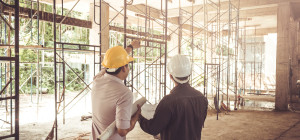Hoists, which have a long history dating back to at least the 1800s, have become a crucial part of so many industries around the world. Without them, manufacturing plants wouldn’t operate as efficiently, construction projects would take longer to finish, and the everyday products and consumables that we use may not even exist!
Having such an importance for this wide range of industries, it’s hardly surprising that there are now thousands of different types of hoists from hundreds of manufacturers. Each has been designed in its own way with its own array of benefits.

Lifting hoists help with construction projects
But, despite this, they all work in a similar way, and so the same tips apply to each of them. With hoists often handling heavy loads, it’s important that you follow recommended lifting hoist usage tips, keeping you safe in the workplace.
Compliance with regulatory and legal guidelines
The most important way that you can ensure that you stay safe in the workplace is by first referring to, and learning, all necessary government and manufacturer guidelines. The most important guidelines that you must stay fully compliant with are the Lifting Operations and Lifting Equipment Regulations 1998 (LOLER). This states that that any operation involving lifting hoists or other equipment must:
- Be planned properly by a competent person
- Also be supervised by a competent person
- Be carried out in a safe manner
Given that LOLER requires operations be carried out in a safe manner, and provides guidelines on how to do so, following these rules is the surest way of keeping safe in the workplace.
You can also refer to the Lifting equipment at work guidelines from the HSE, which offers general information on LOLER. It’s important to note that both of these have been produced under the Health and Safety at Work Act, and so form part of the law.
Planning an operation
As touched on above, it’s imperative that a lifting operation is planned properly. Here are some lifting hoist usage tips when scoping out your operation.
Environment
The environment that you’ll be operating in is one of the first factors that you’ll need to consider. Your hoist will work as an accessory with another piece of lifting equipment, typically a crane, and its best that your setup is on a flat, even surface and in a dry environment.

It’s important that lifting operations are only conducted on flat surfaces!
This will keep your load balanced and centred, avoiding any unexpected swinging of loads, and will ensure that your hoist doesn’t rust or corrode in any harsh environments. Also make sure that the area around your operation is completely clear of any objects, and it is also recommended to install warning signs nearby so that anyone in the area is aware of the ongoing operation.
Hoist operative
As LOLER states, it’s important that only a competent person is used for the planning of a lifting operation. For this, it is recommended to only use adults over the age of 18, and one who is fully trained or qualified in the use of lifting hoists. With this should also come full knowledge of both industry and manufacturer’s guidelines.
Personal Protective Equipment (PPE)
PPE is recommended for all lifting operations. Depending on the type of operation, for instance working at height, you may need other types of gear. But, as standard, you should equip all workers with safety helmets and protective eye glasses during a lifting operation.
Lifting hoist usage tips; during an operation
Once you have planned an operation, it’s important to think about the lifting hoist usage tips that will benefit you during the operation itself:
- Make sure that your hoist is securely attached to the crane that it is operating with
- Have patience during an operation and avoid any rushed or jerky movements
- Always stick to the manufacturer’s guidelines when it comes to weight limits of loads. This is perhaps the most important tip, as failure to do so makes a lifting operation, and its results, entirely unpredictable
- Keep the load secure and centred at all times
- Thoroughly consider the job before you begin operation. With dozens of hoists on the market, it’s important that you choose the right one
Find out more about keeping safe in the workplace
To find out more about lifting hoist usage tips, it is always recommended to speak to experts in the field or refer to recommendations that they have set out. Infographics such as Safety Tips for the Effective Use of Lifting Hoists from Lifting Hoists Direct are brilliant guidelines from those in the industry.

Infographic from Lifting Hoists Direct
Following these recommendations will not only keep you safe in the workplace, but they will also ensure that you get the maximum efficiency out of your hoist, while prolonging its service life too.







